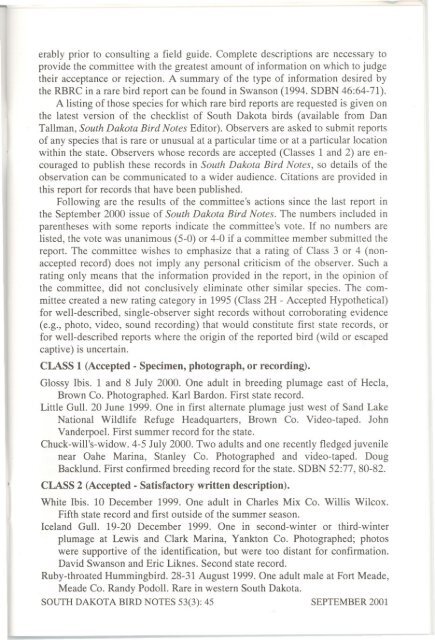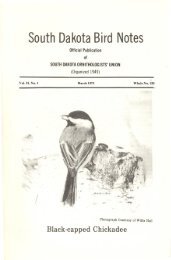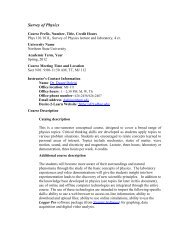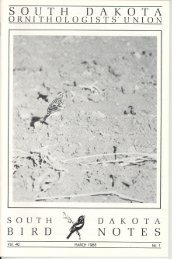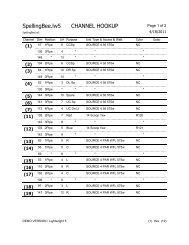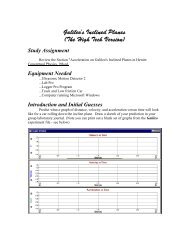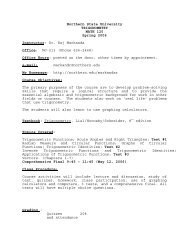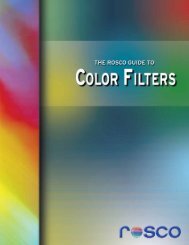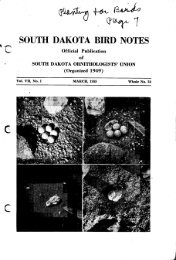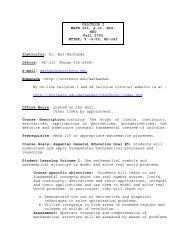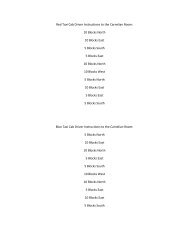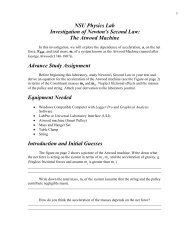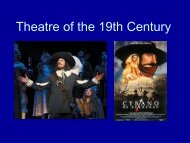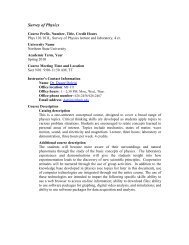Vol 53, 2001 - Northern State University
Vol 53, 2001 - Northern State University
Vol 53, 2001 - Northern State University
You also want an ePaper? Increase the reach of your titles
YUMPU automatically turns print PDFs into web optimized ePapers that Google loves.
-erably prior to consulting a field guide. Complete descriptions are necessary toprovide the committee with the greatest amount of information on which to judgetheir acceptance or rejection. A summary of the type of information desired bythe RBRC in a rare bird report can be found in Swanson (1994. SDBN 46:64-71).A listing of those species for which rare bird reports are requested is given onthe latest version of the checklist of South Dakota birds (available from DanTallman, South Dakota Bird Notes Editor). Observers are asked to submit reportsof any species that is rare or unusual at a particular time or at a particular locationwithin the state. Observers whose records are accepted (Classes 1 and 2) are encouragedto publish these records in South Dakota Bird Notes, so details of theobservation can be communicated to a wider audience. Citations are provided inthis report for records that have been published.Following are the results of the committee's actions since the last report inthe September 2000 issue of South Dakota Bird Notes. The numbers included inparentheses with some reports indicate the committee's vote. If no numbers arelisted, the vote was unanimous (5-0) or 4-0 if a committee member submitted thereport. The committee wishes to emphasize that a rating of Class 3 or 4 (nonacceptedrecord) does not imply any personal criticism of the observer. Such arating only means that the information provided in the report, in the opinion ofthe committee, did not conclusively eliminate other similar species. The committeecreated a new rating category in 1995 (Class 2H - Accepted Hypothetical)for well-described, single-observer sight records without corroborating evidence(e.g., photo, video, sound recording) that would constitute first state records, orfor well-described reports where the origin of the reported bird (wild or escapedcaptive) is uncertain.CLASS 1 (Accepted - Specimen, photograph, or recording).Glossy Ibis. 1 and 8 July 2000. One adult in breeding plumage east of Hecla,Brown Co. Photographed. Karl Bardon. First state record.Little Gull. 20 June 1999. One in first alternate plumage just west of Sand LakeNational Wildlife Refuge Headquarters, Brown Co. Video-taped. JohnVanderpoel. First summer record for the state.Chuck-will's-widow. 4-5 July 2000. Two adults and one recently fledged juvenilenear Oahe Marina, Stanley Co. Photographed and video-taped. DougBacklund. First confirmed breeding record for the state. SDBN 52:77,80-82.CLASS 2 (Accepted - Satisfactory written description).White Ibis. 10 December 1999. One adult in Charles Mix Co. Willis Wilcox.Fifth state record and first outside of the summer season.Iceland Gull. 19-20 December 1999. One in second-winter or third-winterplumage at Lewis and Clark Marina, Yankton Co. Photographed; photoswere supportive of the identification, but were too distant for confirmation.David Swanson and Eric Liknes. Second state record.Ruby-throated Hummingbird. 28-31 August 1999. One adult male at Fort Meade,Meade Co. Randy Podoll. Rare in western South Dakota.SOUTHDAKOTABIRDNOTES<strong>53</strong>(3):45 SEPTEMBER <strong>2001</strong>- - -- --


